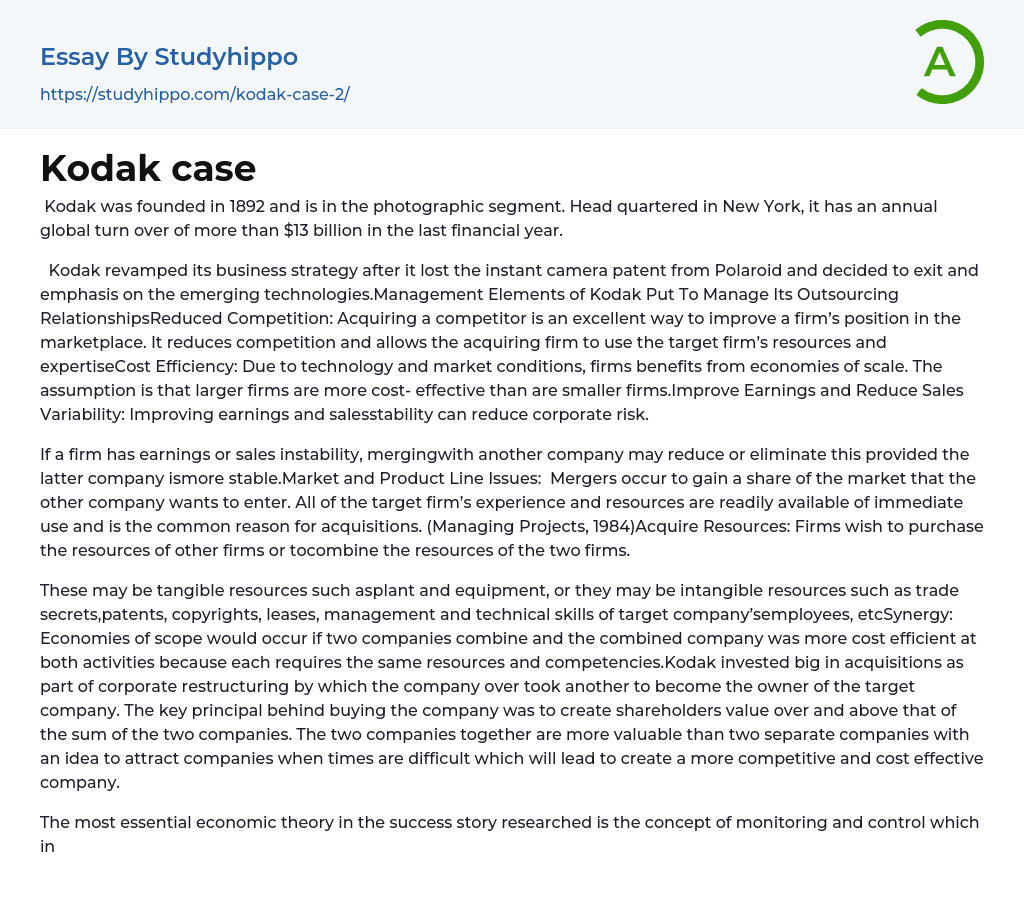Kodak, situated in New York and founded in 1892, works within the field of photography. Its worldwide earnings exceeded $13 billion during the prior financial year.
Kodak overhauled its business strategy when it lost the instant camera patent to Polaroid and chose to prioritize emerging technologies. Management elements of Kodak were put in place to manage outsourced relationships. Acquiring a competitor is a means for a firm to enhance its market position by reducing competition and taking advantage of the target firm's resources and knowledge. Economies of scale resulting from technology and market developments enable firms to achieve cost efficiency, with larger ones being deemed more cost-effective than smaller ones. The improvement of earnings and sales stability can also decrease corporate risk.
If a company is financially unstable due to fluctuating earnings or sales, a potent
...ial solution is to merge with a more stable company. Mergers can also occur for market and product line purposes, as companies may seek to enter a market that the other company already occupies. This allows the acquiring company immediate access to the target firm's experience and resources. Additionally, firms may acquire resources from other companies or combine their resources through mergers.
The resources that a company may possess can be split into two categories: tangible resources, such as plant and equipment, and intangible resources, such as trade secrets, patents, copyrights, leases, and the management and technical skills of the target company’s employees. When two companies combine, a synergy occurs in the form of economies of scope. This is because the combined company can be more cost-efficient in both activities due to the shared resources and competencies.
As part o
its corporate restructuring, Kodak invested heavily in acquisitions. By taking over another company, Kodak became the owner of the target company with the aim of creating shareholder value above and beyond that of the sum of the two companies. The key principle behind this was to attract struggling companies, which would lead to a more competitive and cost-effective company.
According to the researched success story, the most crucial economic theory is monitoring and control. This theory involves having knowledge of the decision's status, comparing it to the plan through control, identifying deviations, and initiating corrective actions to meet the original plan. Effective project management lies at the heart of corrective actions, which necessitate a measurement system that effectively measures results at scheduled intervals and compares them to planned outcomes. Kodak's rise over Polaroid in photography's core business domain was aided by the strategic decisions made at various levels. Fig 6: Strategic Decisions at Different Levels. References 1. Eastman Kodak Case Book,1,1989.
- Finance essays
- International Business essays
- Macroeconomics essays
- Barriers To Entry essays
- Microeconomics essays
- Pricing essays
- Profit essays
- Consumerism essays
- Export essays
- Free Trade essays
- International Trade essays
- Compensation essays
- Monopoly essays
- Trade essays
- Industry essays
- Warehouse essays
- Economic Development essays
- Economic Growth essays
- Inflation essays
- Taxation essays
- Central Bank essays
- Monetary Policy essays
- Economy essays
- Gross Domestic Product essays
- Recession essays
- Capitalism essays
- Economic System essays
- Materialism essays
- World economy essays
- American Dream essays
- resources essays
- Max Weber essays
- Employment essays
- Minimum Wage essays
- Unemployment essays
- Human Development essays
- Income Inequality essays
- Economic Inequality essays
- Money essays
- Financial Accounting essays
- Market Segmentation essays
- Supply And Demand essays
- Purchasing essays
- Forecasting essays
- Legacy essays
- Bank essays
- Corporate Finance essays
- Financial News essays
- Financial Ratios essays
- Financial Services essays




